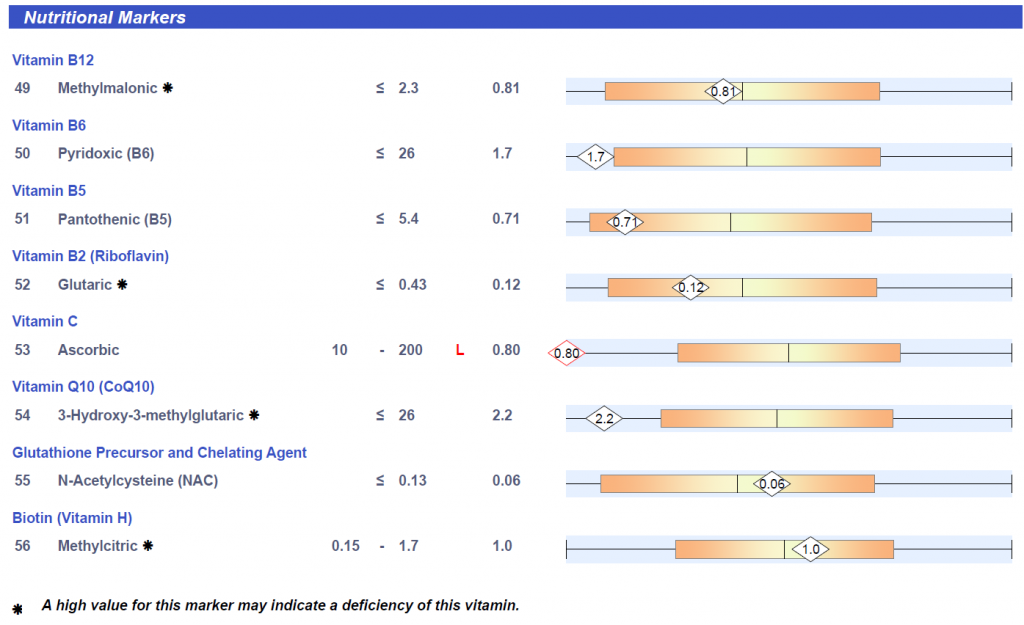This is a continuing series of blogs looking at OATS results and autism. The goal is to filter out items that are relevant to autism. The series is not intended to do a full explanation of the OATS test or a single person’s result. The OATS test is not autism specific but general health (often IBS/FM/CFS focuses).
Remember that our knowledge is constantly changing (unfortunately most MDs knowledge of the literature is stale).
Panel A

- 3-Hydroxybutyric
- Acetoacetic – nothing explicit [2018][2019]
- 4-Hydroxybutyric (gamma-hydroxybutyric acid) – high levels may be associated to specific DNA. [2019] [2016] [2009]
- Ethylmalonic
- ” ethylmalonic acid (P = 0.043) were significantly elevated in individuals with ASD.” [2020] – in this case not
- Methylsuccinic – nothing found
- Adipic – again, this child is normal range
- ” the increase in adipic acid concentration was significantly and indirectly correlated with the severity of the deficit in socialization and communication skills in children with an ASD” [2016]
- ” Overall, no increase in the concentration of adipic acid in children with ASDs compared to TD children, however when considering vitamin B supplementation in ASD there were significantly increased level of urinary adipic acid in children with an ASD not taking vitamin B supplementation compared to supplemented children or to TD children. ” [2016]
- B vitamin supplementation reduces excretion of urinary dicarboxylic acids in autistic children [2011] B vitamins lowers
- Significant differences were found between the autistic children and the control group in organic acids: 2-oxoglutaric, isocitric, citric, 4-hydroxybenzoic, 4-hydroxyphenylacetic, hippuric, adipic, suberic (all with p<0.05). [2011]
- Suberic
- “No significant difference were observed in suberic acid. ” [2016]
- Sebacic – nothing found
Panel B

- Vitamin B12
- “For example, levels of vitamins B1, B6, B12, A and D are often reported to be low in ASD children. ” [2020]
- Vitamin B6
- “For example, levels of vitamins B1, B6, B12, A and D are often reported to be low in ASD children. ” [2020]
- Vitamin B5
- “Based on semi-blinded assessment, the treatment group, compared to the non-treatment group, had significantly greater improvement in autism symptoms and developmental age. The treatment group had significantly greater increases in EPA, DHA, carnitine, and vitamins A, B2, B5, B6, B12, folic acid, and Coenzyme Q10. ” [2018]
- Vitamin B2
- “Based on semi-blinded assessment, the treatment group, compared to the non-treatment group, had significantly greater improvement in autism symptoms and developmental age. The treatment group had significantly greater increases in EPA, DHA, carnitine, and vitamins A, B2, B5, B6, B12, folic acid, and Coenzyme Q10. ” [2018]
- Vitamin C
- The risk for scurvy in children with neurodevelopmental disorders [2020] – “Most affected children had a previous diagnosis of a medical or developmental condition (especially autism spectrum disorder)”
- Scurvy as a Sequela of Avoidant-Restrictive Food Intake Disorder in Autism: A Systematic Review [2020]
- Associations Between Broader Autism Phenotype and Dietary Intake: A Cross-Sectional Study (Japan Environment & Children’s Study) [2020] “consumed less vegetables, fruits, and fish and shellfish, and they consumed lower folate, vitamin C, vitamin D, and n-3 PUFA than their counterparts.”
- CoQ 10
- “Based on semi-blinded assessment, the treatment group, compared to the non-treatment group, had significantly greater improvement in autism symptoms and developmental age. The treatment group had significantly greater increases in EPA, DHA, carnitine, and vitamins A, B2, B5, B6, B12, folic acid, and Coenzyme Q10. ” [2018]
- NAC
- “We concluded that N-acetylcysteine is safe and tolerable, reduces hyperactivity and irritability and enhances social awareness in children with autism spectrum disorder. ” [2020]
- Biotin
- “Low levels of biotin, plasma glutathione, RBC SAM, plasma uridine, plasma ATP, RBC NADH, RBC NADPH, plasma sulfate (free and total), and plasma tryptophan; also high levels of oxidative stress markers and plasma glutamate.” [2011]